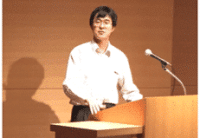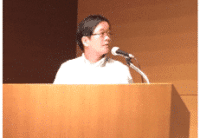08:47 BST
What value would you give to your smartphone devoid of a network connectivity? What if the information and communication technology suddenly disappears following a disaster? Keep reading to dive into the details!

22nd September 2015, a pleasant day under the ambience of Hyatt Regency in Kyoto, Japan,IEEE Microwave Theory and Techniques Society (MTT-S) SIGHT organized a Workshop tagged as ‘Resilient ICT for Disaster Relief in Japan’ under the leadership of Hiromitsu Wakana. ICT corresponds to Information and communication systems that integrates the information technology (IT) and telecommunications together. The workshop commenced with welcome speech by Dr.Tim Lee, IEEE MTT-S President. About five papers on Information and communication technology (ICT) targeting to disaster mitigation was presented. Let’s have a glance over the details!
ICT in the Enhancement of Societal Resiliency against Natural Disasters of the Strategic Innovation Promotion Program, SIP
 Dr.Hiroshi Kumagai from National Institute of Information and Communications Technology, NICT presented a paper on the development of resilient ICT against natural disasters conducted under the government program of SIP. The study concentrates on rapid as well as widespread broadcasting of information to local residents and restoration after disaster. Most importantly, a quick deployment of research outcomes into the society is the target of the program.
Dr.Hiroshi Kumagai from National Institute of Information and Communications Technology, NICT presented a paper on the development of resilient ICT against natural disasters conducted under the government program of SIP. The study concentrates on rapid as well as widespread broadcasting of information to local residents and restoration after disaster. Most importantly, a quick deployment of research outcomes into the society is the target of the program.
Development and Field Trials on Wireless Relay Using Small Unmanned Aircraft
 Imagine a situation when the mobile towers around your area fail following a disaster and you need to contact the rescue team or your dear ones. It’s time for our ‘rescue aircraft’ to take off. Dr. Ryu Miura from National Institute of Information and Communications Technology (NICT) presented an amazing technology that provides a rapidly deployable wireless relay system using small unmanned aircraft to provide a temporary communication link with isolated disaster stricken areas in large-scale disasters. The unmanned aircraft gives a virtual radio tower to relay signals between the isolated area and a normal area where the Internet is alive. The camera functionality onboard acts as a strong agent to collect comprehensive disaster information with safety situations on victims and the images in the damaged and isolated areas. The paper overviews the system and past field trials to evaluate its feasibility in collaboration with satellite communication system.
Imagine a situation when the mobile towers around your area fail following a disaster and you need to contact the rescue team or your dear ones. It’s time for our ‘rescue aircraft’ to take off. Dr. Ryu Miura from National Institute of Information and Communications Technology (NICT) presented an amazing technology that provides a rapidly deployable wireless relay system using small unmanned aircraft to provide a temporary communication link with isolated disaster stricken areas in large-scale disasters. The unmanned aircraft gives a virtual radio tower to relay signals between the isolated area and a normal area where the Internet is alive. The camera functionality onboard acts as a strong agent to collect comprehensive disaster information with safety situations on victims and the images in the damaged and isolated areas. The paper overviews the system and past field trials to evaluate its feasibility in collaboration with satellite communication system.
Outline of Movable and Deployable ICT Resource Unit and the Feasibility Study in the Philippines
 Yoshitaka Shimizu from NTT Network Innovation Laboratories presented the concept of Movable and Deployable ICT Resource Unit (MDRU) that enables us to quickly reestablish information and communication technology (ICT) services in disaster-stricken areas. The research also focuses on the architecture, enabling technologies installed and ICT service for MDRU. The paper also introduces a feasibility study conducted on the Cebu Island in the Philippines.
Yoshitaka Shimizu from NTT Network Innovation Laboratories presented the concept of Movable and Deployable ICT Resource Unit (MDRU) that enables us to quickly reestablish information and communication technology (ICT) services in disaster-stricken areas. The research also focuses on the architecture, enabling technologies installed and ICT service for MDRU. The paper also introduces a feasibility study conducted on the Cebu Island in the Philippines.
Multi-Mode Portable VSAT for Disaster-Resilient Wireless Networks
 Dr. Noriharu Suematsu from Tohoku University presented a technology that utilizes satellites for communication when all other terrestrial networks fail. A unit called portable multi-mode very small aperture terminal (VSAT) system for disaster-resilient wireless networks. It can be used as a wireless-local area network (W-LAN) router which is connected to 3rd generation (3G) cellular/Long Term Evolution (LTE) in the normal situation. In the case of a disaster, the connection will be switched to the satellite communication route and thereby providing the Internet environment to the evacuees nearby this VSAT indoor unit. The device is capable of providing Internet connection via a private VSAT network (for example: EsBird, provided by SKY Perfect JSAT) and also through the local authorities satellite communications network system connection via Local Authorities Satellite Communications Organization (LASCOM) network. Another striking feature is that the units can be easily carried and installed by the evacuees and it will operate more than a week by the electric power supplied from a hybrid vehicle (HV) with a fill-up gas tank. The digital front-end technologies for VSAT’s transceiver have already been developed and the demonstration of developed VSAT was carried out in the disaster stricken area.
Dr. Noriharu Suematsu from Tohoku University presented a technology that utilizes satellites for communication when all other terrestrial networks fail. A unit called portable multi-mode very small aperture terminal (VSAT) system for disaster-resilient wireless networks. It can be used as a wireless-local area network (W-LAN) router which is connected to 3rd generation (3G) cellular/Long Term Evolution (LTE) in the normal situation. In the case of a disaster, the connection will be switched to the satellite communication route and thereby providing the Internet environment to the evacuees nearby this VSAT indoor unit. The device is capable of providing Internet connection via a private VSAT network (for example: EsBird, provided by SKY Perfect JSAT) and also through the local authorities satellite communications network system connection via Local Authorities Satellite Communications Organization (LASCOM) network. Another striking feature is that the units can be easily carried and installed by the evacuees and it will operate more than a week by the electric power supplied from a hybrid vehicle (HV) with a fill-up gas tank. The digital front-end technologies for VSAT’s transceiver have already been developed and the demonstration of developed VSAT was carried out in the disaster stricken area.
Urban Disaster Simulation Incorporating Psychological Models in Human Evacuation Behavior
 Here comes an interesting research by Tatsuya Yamazaki from Niigata University on evacuation simulation model with human psychological models for urban disaster situation. The system incorporates two psychological models namely psychological delay and emotional contagion. Psychological delay is the initial evacuation delay caused by a belief that abnormal events rarely happen. Emotional contagion is the effect of one person’s emotional state on the emotional state of people around him/her both explicitly and implicitly. The simulated experimental results show that the proposed model provides accurate evacuation behaviors than the normal behavior model without psychological consideration.
Here comes an interesting research by Tatsuya Yamazaki from Niigata University on evacuation simulation model with human psychological models for urban disaster situation. The system incorporates two psychological models namely psychological delay and emotional contagion. Psychological delay is the initial evacuation delay caused by a belief that abnormal events rarely happen. Emotional contagion is the effect of one person’s emotional state on the emotional state of people around him/her both explicitly and implicitly. The simulated experimental results show that the proposed model provides accurate evacuation behaviors than the normal behavior model without psychological consideration.
While man can’t change when, where or how often a disaster occur, he always chase the rainbow above the mighty wings of mitigation measures! And now we believe that the answers to the questions raised in the beginning is almost certain in your mind!
~Reported by Atsushi Sanada & Libin Philip